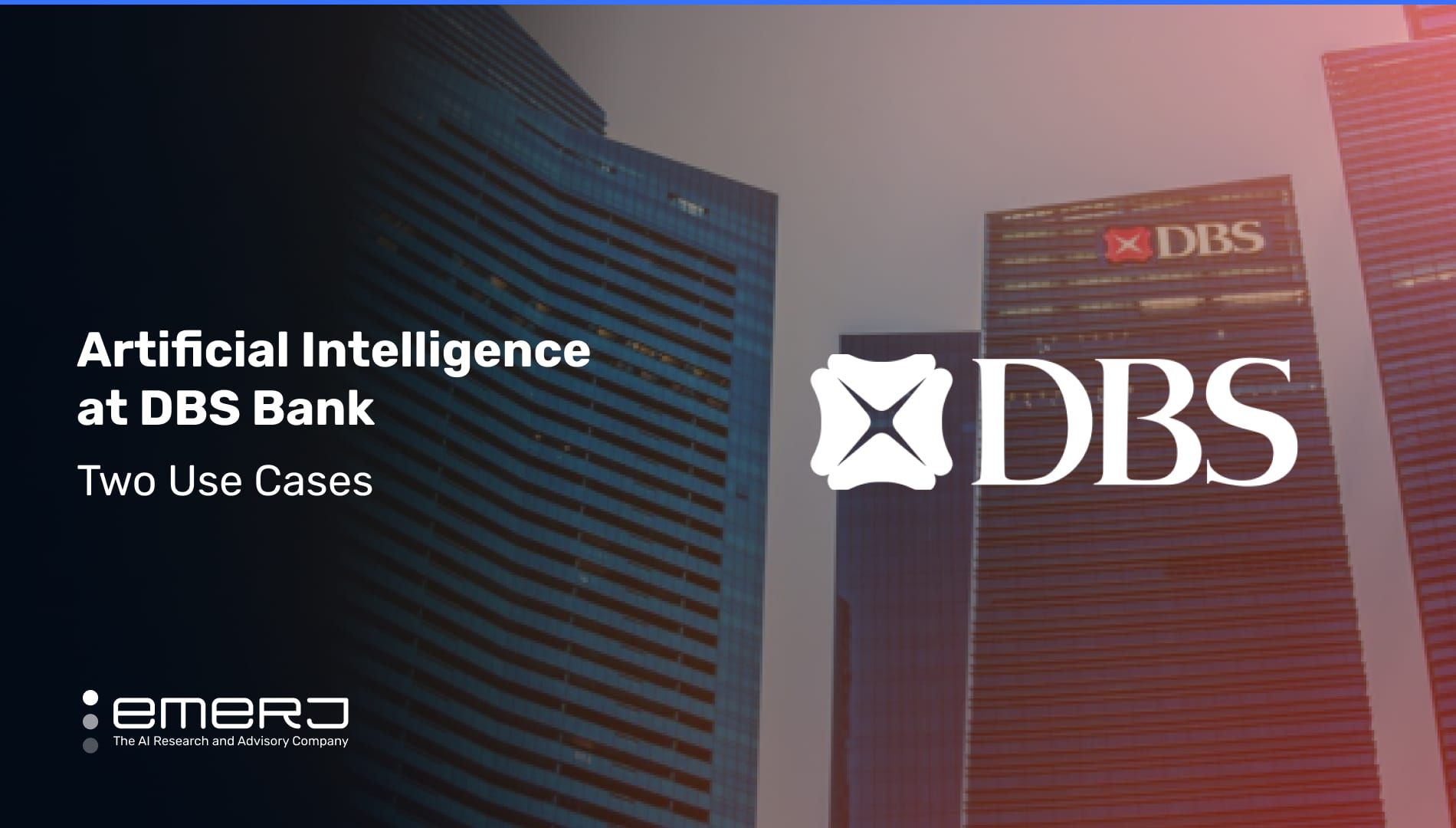DBS Bank is a Singaporean multinational banking and financial services company. The bank has over 150 branches in Singapore alone and by total assets, DBS is the country’s largest bank.
Per the bank’s 2021 Annual Report [pdf], DBS earned approximately $6.8 billion in net income on $14.3 billion in revenue. DBS Bank is owned by the DBS Group, which has a reported market capitalization of approximately $61.6 billion.
The bank employs 33,000 globally and trades on the Singapore Exchange.
DBS is unique in the still-conservative banking industry in that its various technological innovations have garnered worldwide admiration, including from prestigious institutions like MIT and Harvard Business Review. The bank has acquired multiple awards and accolades for its design and implementation of technology, including AI and machine learning initiatives.
In this brief primer, we intend to examine two use cases showing how AI initiatives currently support DBS’ business goals:
- Automated Recruiting: DBS streamlines hiring processes using machine learning- and natural language processing-capable chatbots to source and pre-screen job candidates, along with performing and scoring online assessments.
- Transaction Surveillance: DBS uses machine learning to codify customer usage patterns and flag anomalous behavior to prevent fraud.
We will begin by examining how DBS Bank has used machine learning to improve the end-to-end recruiting cycle and save company resources.
Use Case #1: Automated Recruiting
DBS partnered with impress.ai (“Impress”), a Singaporean software development company. Impress develops AI-powered recruitment software.
Impress offers an AI-powered chatbot that purportedly automates and streamlines the end-to-end job application process by pre-screening and assessing candidates and answering interview- and job-related inquiries.
Per DBS’ website, it sought a solution to automate “pre-interview questions and tests that previously had to be carried out at face-to-face meetings.” The bank cited the following statistics and information that may have served as an impetus:
- Recruiters spend one-third of their workday executing repetitive tasks like:
- Answering questions via email
- Making calls to shortlisted candidates
- Screening resumes
The resulting solution for DBS, JIM for “Jobs Intelligence Maestro,” was customized to DBS’ hiring process. Available resources are unclear on the data used in this process, though DBS lists the process on its website.
According to the available information, JIM is multifaceted and appears to include the following recruitment capabilities:
- Resume screening
- Candidate Assessment
- Candidate scoring
In an interview with the website HKatha, the head of HR at DBS Bank, India, Kishore Poduri, states that the platform has expedited the time taken to assess a resume. In a value proposition video for the software (see cited clip below), the recruiter workflow appears to be as follows:
- Selects the competencies required for the job
- Publishes the chatbot on job postings
- Receives qualified candidate details on the dashboard (see figure 1).
On its website, Impress states that its resume-screening process uses algorithms to evaluate candidate resume data against recruiter preferences (likely referring to the “competencies” mentioned earlier.)
The following 1 min, 36-sec video conveys the value proposition for the impress.ai platform:
Following resume upload, it prompts the candidate to complete a pre-screening assessment. According to the long demo video cited at the bottom of the article, the assessment takes about two to three minutes to complete.
Recruiter preference data trains the platform to score a candidate’s resume, pre-screening questions, and assessment. Per the case study cited earlier, it seems that the output of this process is a “high-potential shortlist” of job candidates. In this way, the candidate data is most likely filtered and presented to the recruiter via their ATS.
According to Impress’ product webpage, the client user making the hiring decision can monitor and manages the recruiting process from their platform dashboard.
According to the case study [pdf] published by Impress, the platform integrates with an Applicant Tracking System (ATS). Impress lists three ATS integrations on its website: Taleo, Workday, and SAP Success Factors. This integration apparently syncs assessment scores and candidate reports from JIM to the ATS.
A longer 12 min, 6-sec video follows, which is a full demonstration of the software. This video is handy if you desire the candidate’s perspective:
Since its implementation in 2018, DBS reports that the solution has saved work time equivalent to 40 hours per month. Per the case study cited earlier, Impress reports that its platform:
- Reduced time to hire by 75%
- Saved up to 40 staff hours per month
- Resulted in 800+ hires across Asia
- Decreased candidate attrition from 15% to 3%
- Answered 97% of candidate inquiries without human intervention
- Achieved an average rating score of 4.7 out of 5 from applicants
Use Case #2: Transaction Surveillance
Ever since the Bank Secrecy Act of 1970 became the law of the land in the U.S., a ripple effect led to banks globally being held liable by their respective governments for preventing money laundering.
Traditional transaction surveillance is bound by a rules-based system that assesses transaction data throughout the bank. Transaction surveillance typically involves monitoring customer deposits, transfers, and withdrawals.
The technology works by passing all transaction data to the rule-based system. A human then screens and flags for analysis data matching the conditionals set by the system.
The difficulty with this system is that it creates a massive number of false positives — up to 98 percent. For the business, this means more company resources — human and monetary — are directed toward sifting through reams of data.
According to an interview from The Straits Times with Head of Group Investigation at DBS Bank Elvin Lim, company leadership developed AI and machine learning capabilities in these processes to identify the transaction usage patterns of customer accounts using all available data points.
MIT Press published a book by university professors Thomas H. Davenport and Steven M. Miller called Working with AI: Real Stories of Human-Machine Collaboration. This book detailed the DBS case study, among others.
Per Davenport and Miller, DBS’ new model combines the traditional rules-based system with AI and machine learning capabilities. The result was an augmented system capable of:
- Reviewing the alerts generated by the rule-based system
- Assigning each alert a risk score
- Categorizing each alert into lower, medium- and high-risk categories
- Elucidating the data used for risk categorization for each alert.
They integrate the model with a user platform that can consolidate transaction support data from across the bank and present it on the analyst’s screen.
Prior to model operation, DB analysts would spend two or more hours investigating an alert. After integrating the new model with a platform that incorporates outputs of the rule-based engine, DBS can resolve ⅓ more cases in the same amount of time.



















